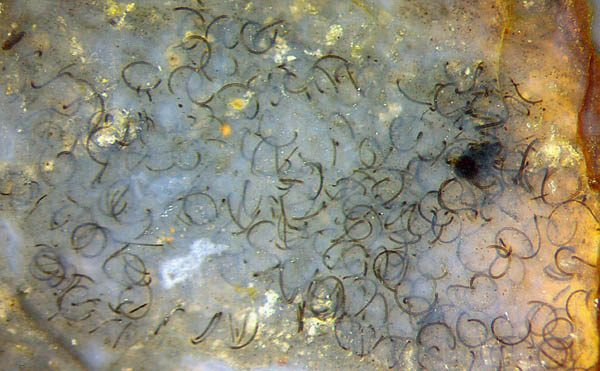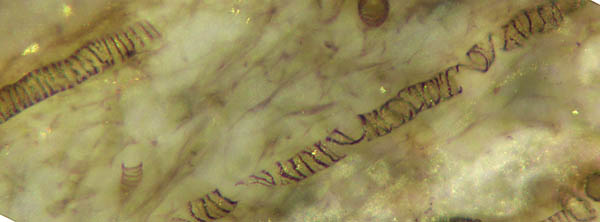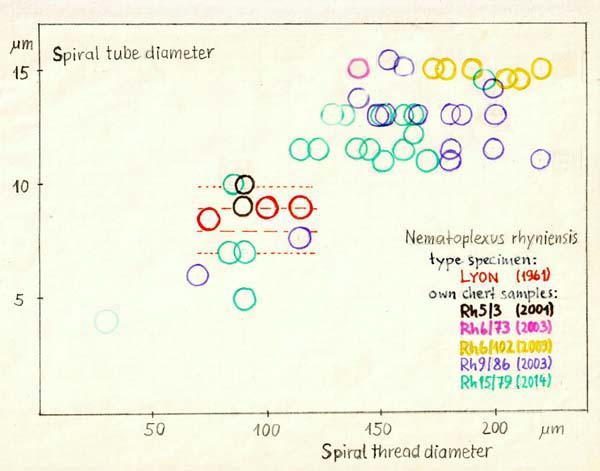Nematoplexus
- enigmatic ever more
Nematoplexus,
one of the rare components in the Lower Devonian Rhynie chert, first
described in 1962
[1] and included into the monograph "Paleobotany" [2] in 2009 as one of
the
"Enigmatic Organisms", has not become less enigmatic in the meantime.
On the contrary, it became ever more enigmatic with own finds of
spirally coiled and other tubes since 2001. 
Loosely coiled or screw-like wound tubes with the pitch of
the thread roughly equal to the diameter of the thread seem to
be a typical feature of Nematoplexus,
by which it
is easily recognized in the chert.
(The statement that "nematophytes appear to generally comprise
networks of intertwined spirally coiled
tubular cells" [3] is simply not true.)
The first Nematoplexus
seen on an own sample (0.28kg) looked
like a larger version of N.
rhyniensis, pictured and compared with the latter in
Rhynie
Chert News 29, under the label Rh9/86.
Two more pictures from the surface of this sample
are
shown here: Figs.1,2.
Fig.1: Wound tubes of Nematoplexus,
bigger than those in [1], and one of the black "branch knots"
which seem to produce the tubes in obscure ways. Picture width 2.4mm. 3.45mm.
Closer inspection of this sample
revealed an unexpected variety of shapes of nematophyte tubes: wound
(spirally coiled) tubes of various size, long fragments of straight
or slightly curved
tubes with various curvature and
diameter, black "branch knots" apparently producing
the tubes. Some worm-like
tubes, with
their annular or spiral wall patterns (Fig.2)
superficially looking like annelids or land plant tracheids,
scattered in the chert or
aggregated in lumps with a tangle of tiny
tubes in between, resemble Nematothallus
[4]. One rare case of extreme differences
in spiral size data is vividly seen in Rhynie
Chert News 106,
there Fig.2. All this, beside the tubular moult
parts of crustaceans
and the tubular branches of charophyte
algae, can be seen within
a few centimeters of surface and cut faces of this sample, and it has
to be untangled so that one can separate things
into those possibly related to Nematoplexus
and others.
The tubes in Fig.1 are of the wound (spiralling)
smooth type with diameters 11-16Ám, except for only one short
fragment of
22Ám width, which is of the patterned type. So it came as another one
of the
several enigmas connected with Nematoplexus
when a multitude of the above-mentioned
worm-like tubes of similar width showed up as a lengthy cluster
only 4cm away
from
the tubes in Fig.1, without any spiralling smooth tube in between, as
seen in
Rhynie Chert News 107,
and as an enlarged detail thereof in Fig.2.

Fig.2: Wall patterns of worm-like
tubes resembling land plant tracheids,
located in the chert sample near the typical spiralling Nematoplexus tubes
in Fig.1 and similar to the non-spiralling patterned Nematoplexus
tubes. Picture
width 0.5mm. Photograph by G. Schmahl.
The similarity between the worm-like
tubes resembling Nematothallus
and the land plant tracheids is possibly not merely superficial but
there may be an essential connection, as pointed out by P.K.
Strother [4].
Very small wound tubes can have a smaller thread than the
spiralling wall pattern of the big worm-like tubes as in Fig.2, which
might cause confusion. (See Rhynie
Chert News 102.)
Apparently never seen before and most probably related to Nematoplexus
are the big "branch knots" in another sample (Rh15/79) with
big slightly curved tubes emerging, first
described in Rhynie
Chert News 71.
Only part of the available information
on Nematoplexus
has been put into the below plot: size data of possibly non-deformed
wound tubes from [1] (picture in [3]) and from 5 own samples. (The
plot includes the data of the table in
Rhynie
Chert News 29. ) The
uncertainty of measurement may be larger than indicated by the circles
in the plot. The dashed lines mark the tube diameters (7)-8-9-(10) Ám
in [1].
(Annotation: The term "spiral", which also applies to a plane curve, is
meant here always in the sense of a screw-like wound curve.)

Fig.3 (right): Spiral tube data of Nematoplexus
taken from images and samples, sorted accordingly.
This plot mainly shows the following remarkable facts:
- The type specimen [1] is restricted to a small area of this
parameter field.
- Bigger spirals are oftener seen than smaller ones.
- There are samples with a wide range of spiral sizes: here
Rh9/86 and Rh15/79.
- The very small spirals are very rare.
The observations give rise to questions:
- Does Fig.3 indicate three separate size regions:
sizes near those of the type
specimen, also many bigger ones and rare much smaller ones ?
- How to interpret the much smaller spirals occasionally seen
among the big ones ?
- Are the straight and slightly curved
smooth-walled tubes always associated with the bigger spirals ?
- Is the presence of what seems to be Nematothallus
(Fig.2) near
Nematoplexus incidental or not ?
More
questions, not considered here, arise in connection with the patterned
tubes and the "branch knots". Answers would probably pave the way to a
better understanding of these enigmatic organisms.
Annotation 2020: Fig.3 is to be updated with new data. The smallest thread is probably erroneous and has been deleted: 102.
H.-J.
Weiss
2018 2020
[1] A.G. Lyon: On the
fragmentary remains of an organism referable to the nematophytales,
from the Rhynie chert, Nematoplexus
rhyniensis.
Trans. Roy. Soc. Edinburgh
65(1961-62), 79-87, 2 plates. (Scale
error on Plate I Fig.1: not x19 but x1.5.)
[2] T.N. Taylor,
E.L. Taylor, M. Krings: Paleobotany, Elsevier
2009.
[3] www.abdn.ac.uk/rhynie/nemato.htm
[4] P.K.
Strother:
Clarification of the genus Nematothallus
Lang:
J. Paleont. 67(1993), 1090-1094.
 |
 |
122 |






